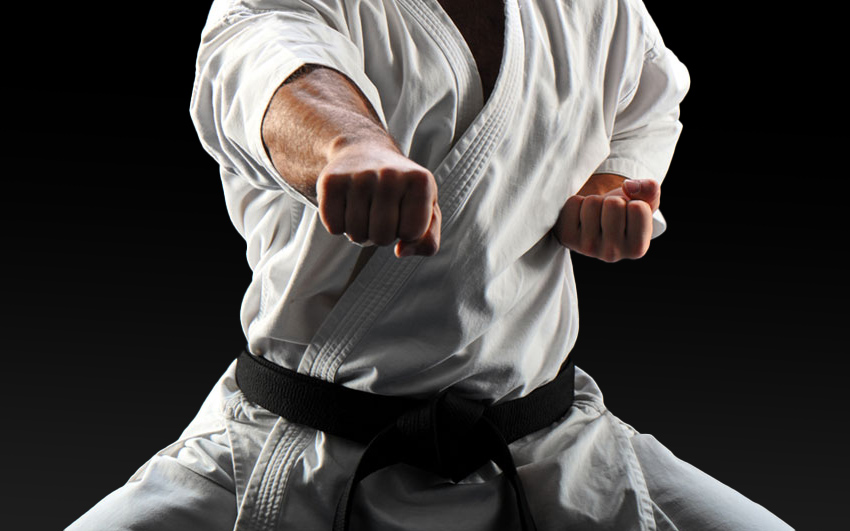How to Drastically Improve the Power of Your Karate Punch?
There are many factors involved in the development of your punching power, ranging from proper biomechanics to breathing.
In this article, I’ll explain the principles of force generations, and I’ll give you advice and tips on how to take your punching power to the next level.
As Karate practitioners, we all want to increase the power of our punches. That’s part of being a karateka, always striving to improve and get better. In order to do that, there are a few principles and applications that need to but assimilated and understood.
Let’s dive in.
Why do Many Karateka Have Weak Punches?
I love Karate as much as you do, but let’s be honest here, many Karate practitioners have weak punches. Of course, power is not everything, but it’s an important attribute to have along with timing, coordination, reflexes, and speed.
That being said, it’s important to understand that our beloved art cannot be “blamed” for such an issue. It’s not karate’s fault, it’s more than the individual making the punch is making it wrong. Let’s examine the reasons why many karatekas have weak punches.
1. Too much muscular tension

Don’t hate me, but in general, Japanese Karate styles – as compared to Okinawan styles – are rigid. As you know, Japanese people tend to be more strict, formal, disciplined and Okinawan are more relaxed, loose and easygoing. Their attitude has a direct effect on their respective Karate styles, philosophy and practice.
You probably read this before. Lao-Tzu, the famous Chinese philosopher, wrote in his equally famous book Tao-Te-Ching: “A man is born gentle and weak; at his death, he is hard and stiff. All things, including the grass and trees, are soft and pliable in life; dry and brittle in death. Stiffness is thus a companion of death; flexibility a companion of life. An army that cannot yield will be defeated. A tree that cannot bend will crack in the wind. The hard and stiff will be broken; the soft and supple will prevail.”
He nailed it right on the head – rigidity is death. Whenever you are physically rigid or tense during physical activity, whether it’s badminton, Karate or anything else, you lose speed, power, and energy.
People practicing basic punches in kiba-dachi stance, tends to tense up: their fists are clenched super tightly, their forearms and arms are tight, hard as steel, like if hardness meant power.
That’s exactly the opposite:
- Tension slows you down: Holding tension in your fists, arms and whole body is drastically slowing your punches down. When your muscles are tense, it takes longer for the stimuli and impulses to go travel from the nervous system to the nerves and muscles. In other words, make it take too long to “deliver” your punch. When you stay relaxed while throwing your punch, you’ll find that its speed is much quicker.
- Tension makes your punches weaker: Muscular tension makes your body so tight, so stiff that it prevents the generated power to unleash into your punch fully. Think of a whip. The reason it’s so powerful is that it generates power in a completely free, non obstructed manner. Rigidity and muscular tension do obstruct power.
- Tension burns you up: When you are tense, you grow tired very quickly. Holding onto tension means your muscles are being overworked, and as such, you burn your energy supplies. When you let go of muscular tension and rigidity, you can train (or fight) for greater periods. Getting rid of that ‘stiffness’ in your Karate will make a big difference in your endurance.
- Tension in your body equals tension in your mind: There is something essential that you have to understand now: rigidity of the body equals rigidity of the mind. If your body is stiff, your mind is stiff, and that’s not something you want. A stiff and rigid mind doesn’t flow, adapt, or react quickly and effectively. The result is delayed reactions, and delayed reactions can put you in a dangerous position during a real encounter.
The key to an effective and enduring Karate is to learn to relax. In a minute, I’ll give you useful tips that will help you do precisely that.
PS: If you want to know more about the differences between Japanese and Okinawan karate, read this article.
2. Poor understanding of biomechanics
Another thing that Karate practitioners struggle with is performing movements, in this case, the punch, with the proper biomechanics or body mechanics. Every technique you perform is enhanced or diminished by the way you move and stand. Bad posture, poor ergonomics, and improper form or technique can cause bad body mechanics which will result is poor speed, power, and stability.
A poor understanding of the proper biomechanics of the Karate punch will not only significantly diminish the quality and the effectiveness of our movement itself, but also the good health of our articulations, tendons, muscles, and body as a whole.
What are proper biomechanics in Karate and martial arts?
Proper body mechanics is the harmonious, natural interaction of your muscles, bones, joints, and breathing working together to produce the ideal and most efficient movement. In the context of this article, proper biomechanics is manifested by using every part of your body correctly to deliver the punch: elbow, shoulder, legs, spine, core, and hips.
I’m sure lots of readers will say, “No, not me, I’ve been practicing Karate for years, I know how to punch. Come on!” You may be right, but I bet you can still improve your Karate punch’s biomechanics so that you can deliver it with optimal effect.
3. Improper Breathing
Unfortunately, too many Karate people don’t breathe properly when delivering their punches, even experienced, seasoned practitioners! Most karatekas are not exhaling while striking; instead, they hold their breath and tighten up their entire body.
I don’t mind what your excuses are, if you don’t breathe properly, there is NO WAY that you are punching to your full potential. Period. If you hold your breath while delivering your Karate tsuki or exhale at the wrong time, you are preventing your body its natural ability to release energy or power, resulting in a weak punch.
What is Punching Power?
On a fundamental level, the primary goal of the Karate punch is to transfer as much destructive power as possible from your body to your opponent.
In other words, power, in our case punching power, is the ability to deliver enough force to render an opponent unconscious, to knock him out or to temporarily disable him by knocking the wind out of him or breaking its bones.
Knockout power is related to timing, speed, technique, precision among other factors. In physics, this power is generated by motion, and it’s called kinetic energy. Scientists can measure kinetic energy by calculating the amount of “energy transferred per unit of time.”
As I mentioned before, although they share similarities, Japanese and Okinawan Karate are entirely different in their application and philosophy. One particular area where they are different is their perception of power and the physicality behind it.
1. Kime
The concept of kime is at the core of Japanese Karate (mainland). In application, Kime is that instant stop at the end of your motion where you freeze your technique quickly, you know, “the snap”. Kime-oriented punches are generally performed with great muscular tension (prior, during and after the strike) in most part of the body, particularly the fist, forearm, arm, and abdominals.
2. Chinkuchi
Okinawan Karate is a different beast, it’s quite different from Japanese Karate in its fundamental principles and applications. In Okinawan Karate you can pretty much forget about the snap. It’s not important to stop your technique in an instant, what is more important is to transfer your energy through the opponent, and that’s called Chinkuchi. The power of Chinkuchi looks more like a quick and progressive push than an explosive strike. Imagine a wave building up and unleashing on the rocks. I love using water metaphor, I really do!
3. Muchimi
Another fundamental principle at the heart of Okinawa Karate is Muchimi or Mochimi. It’s a power generating principle where the practitioner’s body and movements should attain the character of mochi, a popular food in Japan. Mochi is a Japanese sticky rice cake that has an elastic-like texture, almost like rubber.
The principles of Muchimi refers to the fact that the body should be relaxed and flexible like mochi. You start relaxed, and contract only at the moment of impact (not while you ‘launch’ your fist, ONLY at the moment of impact), then finish relaxed and decontracted. It’s actually very similar to the attack of a snake. Before the attack, the snake is relaxed and fluid then suddenly gets tense during its attack, then come back relax immediately after.
Both Chinkuchi and Muchimi should work together
As we saw, Chinkuchi as it relates to helping generate the wave-like feeling of muchimi refers more to the sudden contraction and relaxation of muscles to help transfer momentum in a chained succession through the joints of the body into a technique.
Thanks to the combined power of Chinkuchi and Muchimi, I’ve seen Okinawan masters, I mean elderly gentlemen hit like a truck! They can generate a crazy, out of this world amount of power in their punch and strikes in general. By mastering these two Okinawan Karate power principles, you will also develop awesome power in your Karate punches. I have no doubt that if it can work for them, it can work for you!
The Principles of Power
Now that we studied what power is, it’s time to delve into the basic principles of power. If you ask any scientist what is the formula for delivering a powerful punch, they will definitely answer your question with this simple, yet important formula: F= MxA.
That’s, in fact, Isaac Newton’s second law of motion, and it means that Force equals Mass multiplied by Acceleration. What does that mean? Well, basically it means that the heavier and the faster you are, the harder you’ll hit. Pretty simple right? Simple to understand, but difficult to master.
1. Mass
Before training to improve your speed or acceleration, you want to improve your mass. More mass equals more potential punching power. But what does it mean to improve mass? Does it mean that you’ll have to turn yourself into a Sumo wrestler and eat 20,000 calories per day? Yes! Now go to Wendy’s and eat like there’s no tomorrow!
Just kidding! When I say that I want you to improve mass, I don’t mean that you should actually gain weight. Instead, I want you to use your mass more adequately. I want you to increase the amount of mass you can transfer into the opponent when you punch. But how do you do such a thing?
In order to do this, you need to execute every technique with the proper biomechanics or proper use of your body during a strike. That way, you’ll put much more body weight into your punch, and you’ll be able to generate an insane amount of power into your attack.
Being able to use your entire body weight into your punch, or any other strike for that matter will require a lot to time, training and dedication. We’ll see how it’s done a little further into this article.
2. Acceleration
Now that you understand the purpose of putting body mass into your Karate punch, it’s time to talk about acceleration. Many people believe speed to be the same as acceleration. It’s not.
Speed is the distance covered by a moving object per unit of time, it’s simply how fast an object is moving. Acceleration, on the other hand, is the rate of change of speed, specifically its velocity. In other words, it not about how fast you hit, it’s about how quickly you increase the speed of your mass, in the shortest time possible. In order to achieve tremendous speed in your punch, your body needs to be relaxed and supple. Remember muchimi?
A matter of progression
As your goal is to increase the power of your Karate punch, you should first start by developing the proper body mechanics to improve your mass. Making sure you are using the proper form or execution of a technique is the basis in generating power. After that, it will be necessary to work on improving your acceleration.
You should not focus on developing your Ki too early in your practice, dedicate your time on improving biomechanics and acceleration first. You should start to work on developing internal energy around 4th dan, after you have acquired the basics and applications of Karate and developed excellent biomechanic skills.
How to Generate Punching Power?
In order to generate massive power into your punch, nothing beats Okinawan Karate. It is essential to understand that a proper punch is not just about striking with your fist.
Instead, it’s about transferring the energy through your fist as you hit with your entire body. The power behind the punch is the sum of all the parts you put into it. He is a list of essential points to assimilate and work on in order to increase the power of your punch.
1. Understanding the proper biomechanics
As I have mentioned before, it is vital to understand and master the proper biomechanics in order to deliver a Karate punch with its full potential in terms of power and speed. It allows the technique to flow perfectly through the body, with minimum friction. Punching power is generated from the bottom of your feet through the hips and into the upper and finally into the punch, and all of this is timed carefully with the release of the breath.
a) Keep your body straight
Whenever you punch stand tall with your back straight, keep your spine and neck fully erected, like if you were trying to push the sky with the top of your head. Avoid leaning forward, this will upset your balance and make you punch weakly. Keep your hips or center of gravity a little bit forward. By keeping your back straight, you allow you movement to pivot along the vertical axis of the spine.
b) Let your shoulders move

When delivering a punch, your shoulders should not be stiff, they should be loose and move naturally according to the distance where you give the punch. When you extend your punch, let the shoulder on the same side move forward, and the opposite shoulder moves backward. Too many people keep their shoulders “at the same level” or “even” when they hit, that’s a big mistake. By having stiff shoulders, you block the power of your punch straight at the source.
Keep your punch under control by avoiding overextending or bringing your shoulder too much in front. Keep in mind, even during solo training, not to overexpose your ribs. Try to let your shoulders move whenever you punch, whether it is during horse stance punch practice, kihon, kata or kumite. Remember, movement is life, stiffness is death.
c) Use your hips
To hit with massive power, every component of the punching process is essential, but I would say that the use of the hips is probably the most important one in terms of generating power or kinetic energy. It’s the source where punching power comes from. There are three principles to apply regarding the usage of your hips in Karate, here they are.
i) Rotate your hips

When throwing a punch, your hips should engage and rotate along the vertical axis of your spine and toward your target. This twisting action of the hips will give torque and power to your punch. This way, the force will travel from the hips and manifest itself into a spinal rotation.
ii) Thrust your hips forward
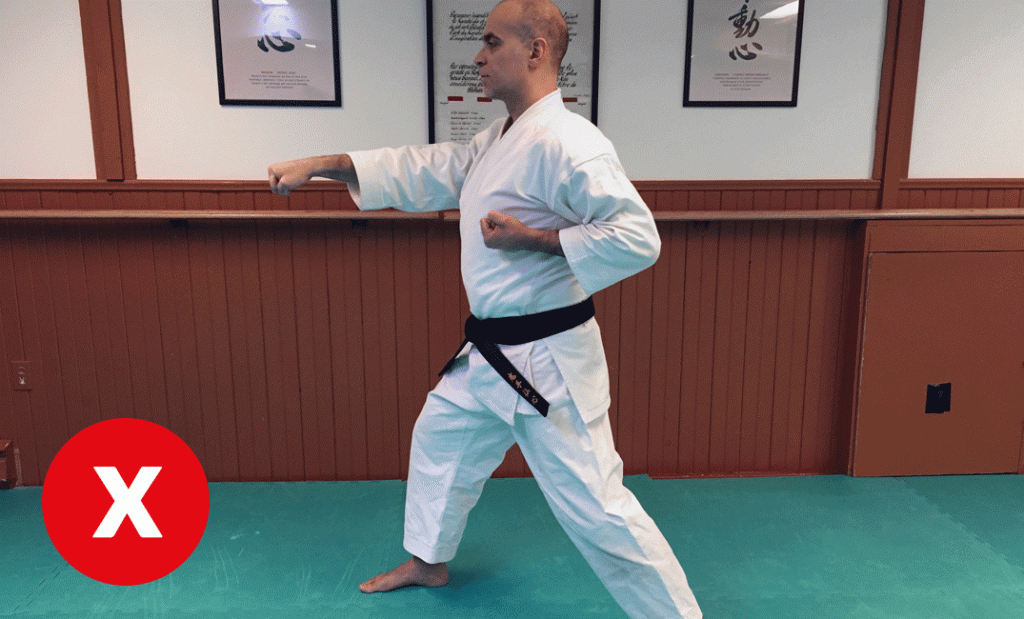
Ok, now you know how to rotate your hips during a punch, but there is more to it. Now, you have to thrust your hips forward and slightly drop your body weight for added power. Remember, to always do this with your spine fully erected, not hunched, you will lose power and explosiveness.
During the punch, your hara, the body’s most important center of energy (located 3 inches below the navel) should be pushed or thrust forward. Imagine looking at your body from a sideways viewpoint; visually, on the vertical axis, your belly should be slightly before your nose. Don’t overdo it. As mentioned before, at the very end of your punch, drop your body weight slightly, it will lower your center of gravity and add more force to your strike.
iii) Tilt your pelvis
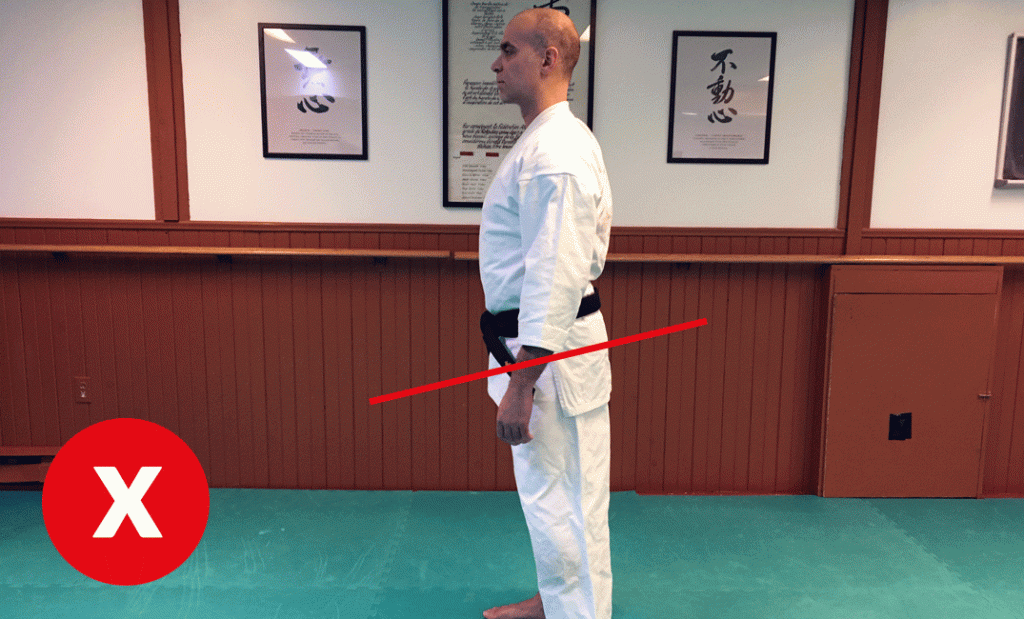
Out of there three hips principles, this one is without any doubt, the most difficult to assimilate and execute – it’s also the most important. At the moment of impact, tilt your pelvis while contracting your lower abdominals. This will not only make your punch very powerful, but it will also make you more stable and allows you to transfer more mass while delivering it. It literally takes years and years of practice only to begin to execute it right.
It is important to remember not to use your back muscles to create an arch in your back but instead using your deep core muscles to till your pelvis and hips. This whole pelvis tilt will feel a little counterintuitive at first, but trust me, once you’ve mastered it, your punching power will never be the same!
d) Use your legs

In order to improve the power of your punch, every part of your body must work together, not separately! Your whole body must work in harmony and cooperation.
Ok, so now you understand that to deliver a powerful punch you need to keep your body is straight and have your shoulders and hips moving the right way, you need to add your legs into the equation. Ahh, one more thing? Yup. Using the power of your legs correctly during the Karate punch will create a line of force straight from the ground, through your foot, leg, and hips, upper body and finally into your punch.
The principle behind the use of the legs while punching is that, no matter what position you are in, one leg will pull and the other will push. For example, let’s pretend that you are punching with your right hand: your left leg should pull and your right leg should push. Your feet need to be firmly rooted into the ground, but ONLY at the moment of the strike. That’s important to understand – you should be reasonably light on your feet while moving, but firmly rooted ONLY when you are striking or blocking. Understood? Good.
The traction that your legs will generate, combined with the power and momentum created by your hips will result in massive force in your punch. The principle can be applied independently of your posture, it works perfectly well in kiba-dachibut also in zenkutsu-dachi, han-zenkutsu-dachi, sanchin-dachi and kokutsu-dachi, etc.
2. Condition your body to strike
To increase your punching power, you also need to condition and prepare your body to hit. It is essential to toughen and strengthen the forearms, the wrists, and the knuckles. There are many ways to do this, but I much recommend the usage of the makiwara and tetsutaba. I also recommend strengthening your core muscles as they are at the heart of every Karate movements and every daily, simple activity like standing, dressing or bathing.
3. Proper breathing
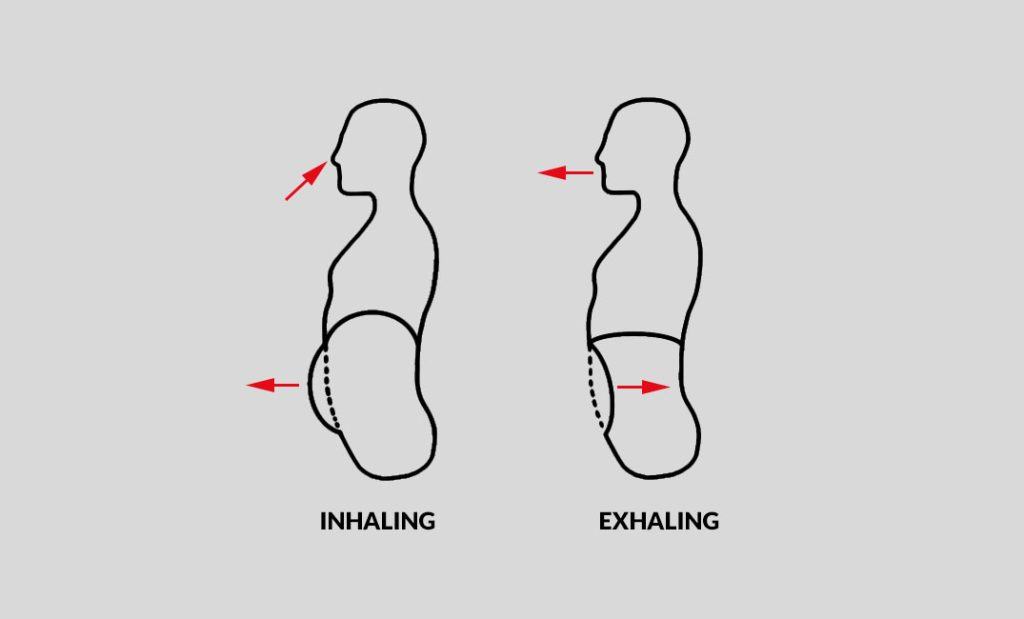
How to breathe correctly in Karate? That’s an important question, as Karate and breathing techniques have an incredibly deep connection with each other. In the various Chinese and Japanese martial traditions, there are a large number of breathing exercises – some are simple and easy while others require years of practice.
Here I will focus only on the proper breathing to adopt during striking or blocking, but I strongly suggest that you deepen your understanding of breath or kokyu in Japanese. As you guess, learning how to breathe correctly will DIRECTLY affect your punching power, speed, stability, and endurance.
a) How to breathe properly?
Most people breath using the upper parts of their lungs only, that’s what we call intercostal breathing. That way, both inhaling and exhaling are done solely in the top body, the lower body does not participate. As air is breathed out, those parts become weak and empty. That’s a very shallow and superficial way to breathe. Actually, it’s is the same breath as a sick person use. That’s not what we want.
In Karate and Zen meditation, we focus on another type of breathing called “diaphragm breathing”. Babies, young children, and animals naturally breathe this way. Diaphragmatic breathing is a deep and profound “lower body” breathing method that makes use of a large internal muscle at the base of the lungs called the diaphragm. This muscle can be activated through the tensing and relaxing of your hara or tanden.
So, when inhaling, instead of expanding your chest and upper abdomen like it’s done with intercostal breathing, try to expand your lower belly, like if you were breathing from it. Of course, you won’t actually breathe through the belly, but that’s the feeling it will give you. By breathing this way, you will pull down the lower part of the lungs, opening up the whole of the lungs and thus pulling in more air. Every breath will be more energizing and will funnily feel more “satisfying” than normal breathing does. Kata like Sanshin and Tensho are excellent for training your diaphragm breathing.
b) How to breathe properly when punching?
Breath is what gives life to your punch. Basically, Karate breathing requires you to inhale (breathe in) throught your nose as you prepare and exhale (breathe out) throught your mouth when you execute your punch. The important point is to exhale whenever you hit and whenever you “receive” a movement (defense). When you exhale, contract your abdominal muscles a bit, and push down on your lower belly. You feel your navel moving toward your spine. Exhaling this way while punching will root your body firmly into the ground and allow you to transfer more mass into your strike.
By removing all the air and space out of your body, you can become momentarily compact, denser, thus allowing you to put more power behind your punch. If you are not attacking or defending, just you breathe naturally, don’t mainly focus on exhaling, just keep a calm, controlled breath.
Also, it’s worth mentioning that if you don’t breathe properly (like holding your breath) during strikes, chances are you will gas out pretty quickly and lose endurance as a lack of oxygen will make your muscles weak.
c) What are the benefits of proper breathing in Karate?
There are countless benefits resulting in proper breathing, but for the purpose of this article, I will list only the mental and physical benefits related to the practice of Karate (I’m planning on making a whole article covering breathing only).
Mental benefits of breathing
- Helps to concentrate and focus,
- Gives more mental clarity and alertness,
- Helps us calm down the mind,
- Helps to control our emotions,
- Helps feeling more energetic.
Physical benefits of breathing
- Helps fight fatigue,
- Increases physical endurance,
- Helps to let go of pain,
- Helps with the proper biomechanics,
- Increases posturing and ‘rooting’,
- Helps create acceleration or explosiveness,
- Helps to transfer more mass into your punch,
- Makes you punch (or any other strike) faster and more powerful,
- Increases the activity of your ki.
If you want to learn more about martial arts and breathing, please read this excerpts from the book “The Essence of Budo” by sword Master Kawakubo Takiji, it’s a great read.
4. Ki
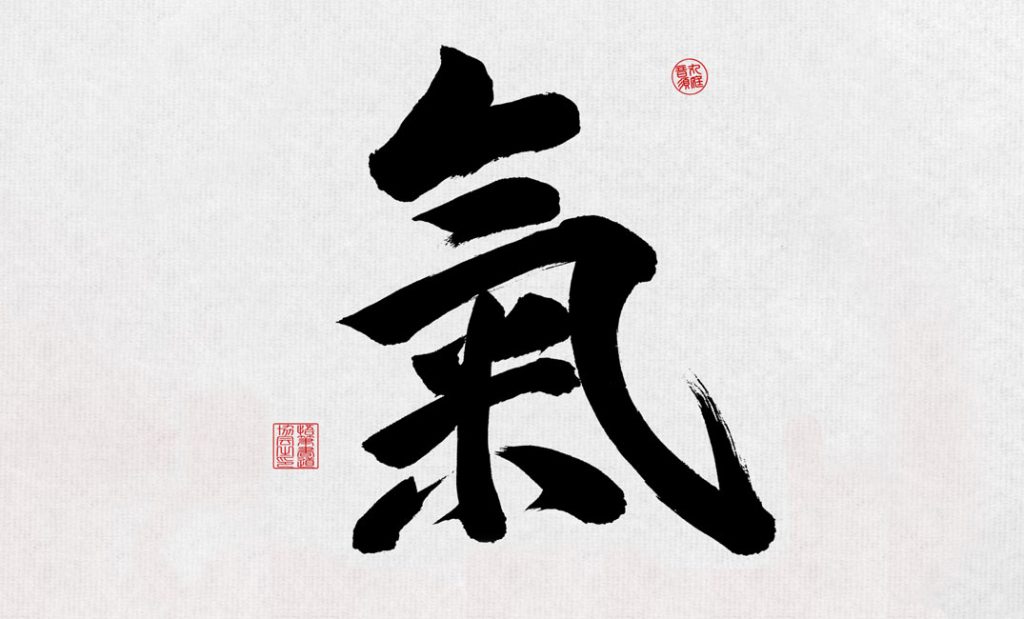
Unfortunately, when we think about ki, we think about those silly YouTube videos where so-called “masters” magically send out flying one, two, sometimes five opponents, without even touching them! These charlatans cast a negative shadow over the concept of ki as a whole. That being said, it’s not because those demonstrations are rubbish that the existence of ki should be dismissed.
What is Ki?
Ki is basically the life force that is within all living being and is the basis of Chinese and Japanese philosophy and medicine like acupuncture, shiatsu, and herbalism. Those practices are based upon the assumption that the body is composed of subtle energy. This subtle energy works within the physical body, and it is a vital component of the physical body. Without ki, there is no physical organic life.
Obi-Wan Kenobi described ki perfectly well in Star Wars: “It’s an energy field created by all living things. It surrounds us and penetrates us; it binds the galaxy together.” Actually, that was a description of the Force, but the same can be said about ki as well.
This principle of a life force is a very old – a few millennia old – concept and can be found in most of the ancient Eastern cultures where it is called ki in Japan, chi in China and prana in India.
What are the benefits of using Ki in Karate?
Even though internal energy or ki is present in every living being, it can be increased and cultivated (for different purposes) in a human being. Karate practitioners martial artist developed ki to a greater extent through various breathing, strengthening and visualization exercises.
In both Chinese and Japanese martial arts, ki is said to originate in the abdomen (Tan Tien in Chinese, Hara or Tanden in Japanese) and can be focused in any part of the body.
As a Karate practitioner, developing your ki will help you to
- Strengthen your hara,
- Improve the power and stability of your positions (rooting),
- Increase the acceleration (speed) and strength (mass) of your strikes,
- Harmonize your breathing with your movements,
- Focus your mind
How to drive your Ki?
Ok, now that’s a tough topic to write about. It’s a bit like Zen, it’s something that has to be experienced, not described or talked about. Anyway, I’ll give it a try.
From a health perspective, ki or energy should circulate throughout your entire body, without disruption, in a smooth, powerful fashion. If the circulation of your ki is blocked, you’ll have pain and disease.
Please keep in mind that your ki, your energy, is always moving. From a Karate perspective, it’s possible to consciously, willingly drive your ki into various parts of the body, depending on your needs. So if you punch, you want your ki to circulate or flow from your legs, to your hips, to your upper body, to your fist and finally to your opponent. If you move, you wanna bring your ki every into your legs. Right? RIGHT?
How to use your ki?
There are many ways to make your ki circulate into the desired body parts consciously. This is accomplished through posture, movement, breathing, and intention. We’ve already covered the first three, so let’s talk about intention.
Ki is a fluid, thought-responsive energy, and it will flow wherever your intention wants it to go within your body. In other words, your mind can guide the direction and location of ki. All you have to do is demand or ask your ki to go to the desired body part. So if you punch, as you ki to go to your fist. Of course, that’s accomplished in a fraction of second. With time, you won’t even have to think about it, it will do it naturally and automatically with greater efficiency.
The ability to generate and use internal power or Ki is quite simple but takes years to develop it enough to make use of it in Karate. Once you did, your strikes will generate a phenomenal amount of strength, we’ll calculate the force of your strikes in horsepower!
5. Putting it all together

Now that’s where things get a little complicated – you have to put it all together. That’s not an easy task, I’m telling you. In order to progress and put all the pieces of the puzzle together, it’s important to take time to develop each principle or techniques on its own. For example, when you focus on biomechanics, focus on it and nothing else. Work each aspect of it, practice, train until you achieve a good level of skills with each. Then, and only then you should start to put it together.
Conclusion
As I said before, improving your Karate punching power is not an easy task, but it’s something that every true Karate practitioners ought to do.
Go slowly, take your time and make sure to understand and execute every component of the punch the right way. Every piece of your punch must work together efficiently and in harmoniously. This is when Karate truly becomes an art.
So, ready to train hard?
- 10 Ways Meditation can Improve Your Karate - March 6, 2024
- Is Tai Chi Effective for Self-Defense? - February 16, 2024
- Do You Need to Add Ground Grappling Into Your Karate? - February 15, 2024

